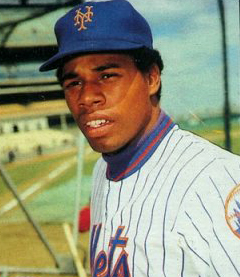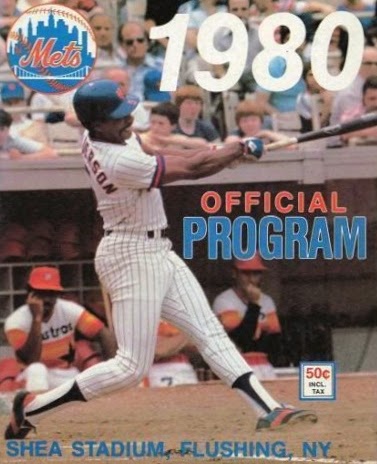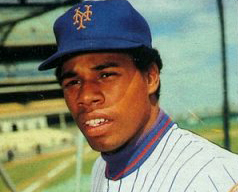Steve Henderson came to the Mets with the burden of being one of the key players coming over from the Reds in the 1977 Tom Seaver trade. In addition, since the Mets had just traded Dave Kingman to San Diego, Henderson was expected to eventually replace him in the middle of the Mets’ lineup. This was an awful lot of pressure for a kid who had never spent a day in the major leagues, but Henderson responded.
 Exuberant, energetic, and most of all productive, Steve was an immediate sensation with the Mets. The talented rookie came up with a lot of big hits and put up very impressive numbers in his first year with the team. Driving in 65 runs in just 99 games.
Exuberant, energetic, and most of all productive, Steve was an immediate sensation with the Mets. The talented rookie came up with a lot of big hits and put up very impressive numbers in his first year with the team. Driving in 65 runs in just 99 games.
Henderson seemed well on his way to becoming a star, good for 20-25 home runs and 85-100 RBI a year, someone who the Mets could definitely build around and everything they expected when they traded for him. Mets manager Joe Torre was even quoted as saying “Someday the Seaver trade will be referred to as the Henderson trade”.
Of course, that never happened and as the years passed, it sort of became gospel that the Seaver trade was an awful one for the Mets. But a few weeks after the trade, there were many Mets fans, including myself who thought that the trade could actually pay big dividends for the Mets. Henderson seemed to be that rare prospect who came over in a trade who not only offered hope for the future, but made an immediate impact at the Major League level.
In addition to Henderson, the Mets also got :
Pat Zachry, a starting pitcher who was co-rookie of the year in the NL the previous season and who figured to be good for about 12-15 wins a year. Unlike Henderson, Zachry was a sullen, brooding player who rarely smiled and looked like he was always annoyed about something. Fans who were up in arms over losing Seaver took out their frustrations on Zachry (never on Henderson) because he was expected to “replace” Seaver in the rotation. This certainly didn’t make it any easier on Zachry. Actually Pat pitched much better for the Mets in ’77 than he did earlier that season with the Reds and made the NL All-Star team in 1978, but after that he injured his foot kicking the dugout steps one day when he was removed from a game and never was the same pitcher after that.
Doug Flynn, an outstanding defensive infielder who had no hope of breaking into the Reds’ infield but was an immediate starter at second base for the Mets. He was the Mets’ regular at second for the next five years and even won a gold glove, but his batting average was always in the low .200’s.
Dan Norman, the sleeper in the deal, a young outfielder who had 30- homer potential, or so we were led to believe. Norman did very little in several chances with the Mets over the next few seasons and faded from the scene without making any impact.
But Steve Henderson clearly was the prize and he became one of the Mets’ best and most popular players in his first season with the team. He finished a close second in the NL Rookie of The Year voting to future Hall-of-Famer Andre Dawson, but unfortunately, Steve’s first season was also his best.

The following year, he played in 157 games, but his RBI total was the same 65 he produced in far fewer games the year before. His batting average was .266 down from .297, and he hit only 10 home runs, down from 12.
Mets fans hoped it was just a case of the sophomore jinx, but unfortunately, Steve never fulfilled his promise and settled in as a complementary player, and nothing more. His power numbers never improved, although he continued to bat around .300.
Henderson’s most memorable moment as a Met – and it was one that still stirs those who witnessed it – was a majestic three-run homer that completed an improbable five-run comeback in the ninth to give the Mets an electrifying 7-6 victory over the Giants. All hell broke loose.
“Hendu Can Do'” kept flashing on the Diamond Vision scoreboard as the Mets celebrated and rejoiced on the field. Exuberant fans roared their approval, rocking Shea Stadium to its foundation. For one night it felt like pennant fever was back in Flushing.
Frank Cashen eventually dealt Henderson to the Cubs, ironically, for Dave Kingman. When Tom Seaver rejoined the Mets a couple of years later, the Midnight Massacre had come full circle.
After being traded to the Cubs, Henderson had stints with several other big league teams as a part-time player and pinch-hitter. He later served as batting coach at Tampa Bay after coaching in the Pirates and Astros organizations. Today Hendu is the hitting coach of the Philadelphia Phillies.
I will always remember him for his electrifying play in 1977 and how he did his best to try to make fans forget Seaver and Kingman, at least for a while.
















